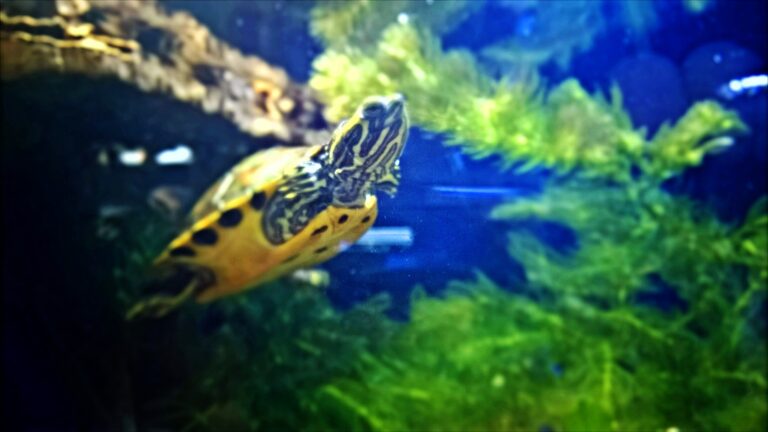How to Maintain a Healthy Habitat: Turtle Tank Cleaning Made Easy
Are you a proud turtle owner looking to provide the best possible habitat for your shelled companion? Keeping a clean and healthy turtle tank is crucial for the well-being of your pet. But let’s face it, turtle tank cleaning can be a daunting task. Fear not, as we have the ultimate guide to make turtle tank maintenance a breeze. In this article, we’ll walk you through step-by-step on how to maintain a healthy habitat for your turtles, ensuring they thrive in a clean and safe environment. From regular water changes to proper filtration systems, we’ll cover all the essential tips and tricks to keep your turtle tank sparkling clean. With our expert advice, you’ll be equipped with the knowledge and tools to create a picturesque home for your turtles, while also preventing any potential health issues. So, let’s dive in and discover the secrets to easy turtle tank cleaning!

The Importance of Maintaining a Clean Turtle Tank
A clean turtle tank is vital for the overall health and well-being of your turtles. Just like any other pet, turtles require a clean and safe environment to thrive. A dirty tank can lead to a host of health problems for your turtles, including shell rot, respiratory infections, and poor water quality. Not only can these issues affect your turtles’ longevity but they can also be costly to treat. By maintaining a clean turtle tank, you can prevent these issues from arising and ensure that your turtles live a happy and healthy life.
Keeping the tank clean also helps to maintain the aesthetic appeal of your turtle’s habitat. A clean tank not only looks visually pleasing but also provides a serene and comfortable environment for your turtles to enjoy. So, by investing some time and effort into regular tank cleaning, you’ll not only improve the health of your turtles but also create a visually appealing habitat that you can be proud of.
To maintain a clean turtle tank, it’s crucial to be aware of the signs that indicate when your tank needs cleaning. Let’s explore these signs in the next section.
Signs That Your Turtle Tank Needs Cleaning
Turtles are messy creatures, and their tanks can quickly become dirty if not properly maintained. Here are some common signs that indicate your turtle tank needs cleaning:
1. **Cloudy or discolored water**: If the water in your turtle tank appears cloudy or has a yellowish tint, it’s a clear indication that the tank needs cleaning. Cloudy water is often caused by a buildup of waste, uneaten food, and algae, which can negatively impact the water quality and the health of your turtles.
2. **Foul odor**: A strong and unpleasant odor emanating from your turtle tank is a definite sign that it’s time for a thorough cleaning. Odor is usually caused by the decomposition of organic matter, such as uneaten food and turtle waste. Regular cleaning helps prevent the accumulation of these waste materials and keeps the tank smelling fresh.
3. **Algae growth**: Algae can quickly take over your turtle tank if left unchecked. Excessive algae growth not only makes the tank look unsightly but can also affect the oxygen levels and overall water quality. If you notice an excessive amount of algae in your tank, it’s time to give it a good cleaning.
Now that you’re aware of the signs that indicate your turtle tank needs cleaning, let’s move on to the tools and supplies you’ll need for effective turtle tank cleaning.
Tools and Supplies Needed for Turtle Tank Cleaning
Before you begin cleaning your turtle tank, it’s essential to gather all the necessary tools and supplies. Here’s a list of items you’ll need for effective turtle tank cleaning:
1. **Gravel vacuum**: A gravel vacuum is a must-have tool for cleaning the substrate in your turtle tank. It helps remove debris, uneaten food, and waste that settle at the bottom of the tank. Ensure you choose a gravel vacuum that is appropriate for the size of your tank.
2. **Bucket**: You’ll need a clean bucket to collect the water you siphon out during the cleaning process. Make sure the bucket is dedicated solely for turtle tank cleaning to avoid cross-contamination.
3. **Sponges and brushes**: Different types of sponges and brushes are useful for scrubbing the tank walls, ornaments, and any other surfaces that need cleaning. Use separate sponges and brushes for different tanks to prevent the spread of potential contaminants.
4. **Water conditioner**: A water conditioner is essential for treating tap water before adding it to the turtle tank. It helps remove harmful chlorine, chloramines, and heavy metals that can harm your turtles.
5. **Testing kit**: A water testing kit is invaluable for monitoring the water parameters in your turtle tank. It allows you to check the pH, ammonia, nitrite, and nitrate levels, ensuring the water quality is optimal for your turtles.
Now that you have all the necessary tools and supplies, let’s move on to the step-by-step guide on how to clean your turtle tank effectively.
Step-by-Step Guide to Cleaning a Turtle Tank
Cleaning your turtle tank doesn’t have to be a complicated process. By following this step-by-step guide, you can ensure that your tank is thoroughly cleaned and your turtles are provided with a healthy environment to thrive in.
Step 1: **Prepare the new water**: Start by filling a clean bucket with fresh water and adding the appropriate amount of water conditioner. Let the water sit for at least 15 minutes to allow the conditioner to take effect.
Step 2: **Remove your turtles**: Carefully remove your turtles from the tank using a net and place them in a temporary holding container with clean water.
Step 3: **Empty the tank**: Using a gravel vacuum, remove water from the tank while simultaneously cleaning the substrate. Vacuum the gravel thoroughly to remove any debris and waste that may have accumulated.
Step 4: **Clean the tank**: Use a sponge or brush to scrub the tank walls, ornaments, and any other surfaces that need cleaning. Rinse everything thoroughly to remove any soap residue.
Step 5: **Refill the tank**: Pour the conditioned water back into the tank, ensuring that the temperature matches the previous water temperature. Fill the tank to the appropriate level, leaving enough space for your turtles to swim comfortably.
Step 6: **Add the turtles back**: Gently place your turtles back into the clean tank, ensuring they are comfortable and secure.
Step 7: **Test and adjust water parameters**: Use a water testing kit to check the pH, ammonia, nitrite, and nitrate levels. Make any necessary adjustments to ensure the water parameters are within the appropriate range for your turtles.
By following these steps regularly, you can maintain a clean and healthy habitat for your turtles.
How Often Should You Clean Your Turtle Tank?
The frequency of turtle tank cleaning depends on several factors, including the size of your tank, the number of turtles, and the efficiency of your filtration system. As a general rule of thumb, it’s recommended to perform a partial water change every two weeks and a thorough tank cleaning every four to six weeks.
However, it’s crucial to observe your tank and turtles closely and adjust the cleaning frequency accordingly. If you notice signs of excessive waste buildup, poor water quality, or any health issues in your turtles, it may indicate the need for more frequent cleaning. On the other hand, if your tank is relatively clean and your turtles are healthy, you may be able to extend the cleaning intervals slightly.
Regular observation and maintenance are key to determining the optimal cleaning schedule for your turtle tank. Remember, prevention is always better than cure, so a proactive approach to cleaning will ensure a healthy and thriving habitat for your turtles.
Tips for Preventing Turtle Tank Odors
Odor control is a common concern for turtle owners. Fortunately, there are several tips and techniques you can employ to prevent unpleasant odors in your turtle tank:
1. **Proper filtration**: Invest in a high-quality filtration system that is suitable for your tank size and turtle population. A good filtration system helps remove waste, excess food, and other impurities that contribute to foul odors.
2. **Avoid overfeeding**: Overfeeding your turtles can lead to excessive waste production, which can result in foul odors. Feed your turtles the appropriate amount of food based on their size and age, and remove any uneaten food promptly.
3. **Regular tank cleaning**: Regularly cleaning your turtle tank is essential to prevent the buildup of waste materials that can cause odors. Follow the step-by-step guide outlined earlier in this article to ensure thorough and effective cleaning.
4. **Maintain proper water quality**: Test the water parameters regularly and make any necessary adjustments to maintain optimal water quality. Poor water quality can contribute to foul odors in the tank.
By implementing these tips, you can keep your turtle tank smelling fresh and clean, allowing you to enjoy your time with your turtles to the fullest.
Common Mistakes to Avoid When Cleaning a Turtle Tank
While it’s essential to know how to clean a turtle tank properly, it’s equally important to be aware of common mistakes that should be avoided:
1. **Using harsh chemicals**: Avoid using harsh chemicals or cleaning agents when cleaning your turtle tank. Many household cleaning products contain toxins that can harm your turtles.
2. **Neglecting filtration system maintenance**: A filtration system requires regular maintenance, including cleaning and replacing filter media. Neglecting this can lead to poor water quality and an ineffective filtration system.
3. **Incomplete tank cleaning**: When cleaning your turtle tank, ensure that you clean all surfaces, including tank walls, ornaments, and filter components. Neglecting any area can lead to the buildup of waste and potential health issues.
4. **Using untreated tap water**: Never add untreated tap water to your turtle tank. Tap water often contains harmful chemicals such as chlorine and chloramines, which can be detrimental to your turtles’ health. Always use a water conditioner to remove these chemicals before adding water to the tank.
By avoiding these common mistakes, you can ensure that your turtle tank cleaning efforts are effective and safe for your turtles.
Natural Cleaning Solutions for a Turtle Tank
If you prefer to use natural cleaning solutions in your turtle tank, there are several options available that are safe for your turtles and the environment:
1. **Vinegar solution**: Mix equal parts of water and white vinegar to create a natural cleaning solution. Use this solution to clean tank walls, ornaments, and other surfaces. Rinse thoroughly to remove any residual vinegar.
2. **Baking soda paste**: Create a paste by mixing baking soda with water. Apply the paste to stubborn stains or areas that require extra cleaning. Scrub gently and rinse thoroughly.
3. **Hydrogen peroxide**: Hydrogen peroxide can be used to remove algae growth on tank surfaces. Apply a small amount directly to the affected areas and scrub gently. Rinse thoroughly to remove any residual hydrogen peroxide.
These natural cleaning solutions are effective alternatives to harsh chemicals and can help maintain a clean and healthy turtle tank.
Troubleshooting Common Turtle Tank Cleaning Issues
Cleaning a turtle tank can sometimes present challenges. Here are some common issues you may encounter during the cleaning process and how to troubleshoot them:
1. **Cloudy water after cleaning**: If your turtle tank water appears cloudy after cleaning, it may be due to a disturbance in the beneficial bacteria colony. To remedy this, monitor the water parameters closely and ensure that the filtration system is functioning correctly. Perform partial water changes if necessary.
2. **Excessive algae growth**: If you notice excessive algae growth shortly after cleaning, it may be an indication of an imbalance in the tank. Check the lighting duration and intensity, adjust the feeding frequency, and ensure that the filtration system is efficient. Consider adding algae-eating fish or snails to help control algae growth.
3. **Strong odor despite regular cleaning**: If you continue to experience a foul odor despite regular cleaning, it may be a sign of an underlying issue with water quality. Test the water parameters and make any necessary adjustments. Consider upgrading your filtration system if needed.
Remember, each turtle tank is unique, and it may take some time and experimentation to find the perfect cleaning routine for your specific setup. Don’t be discouraged by challenges along the way, as maintaining a clean and healthy turtle tank is a continuous learning process.
Conclusion: Enjoying a Clean and Healthy Habitat for Your Turtle
Maintaining a clean and healthy habitat for your turtles is essential for their overall well-being. By following the step-by-step guide and implementing the tips and tricks outlined in this article, you can ensure that your turtle tank remains clean, safe, and visually appealing. Regular cleaning, proper filtration, and vigilant observation of your turtles and tank will go a long way in preventing health issues and allowing your turtles to thrive.
Remember, turtle tank cleaning should be approached with patience and care. With time, you’ll develop a routine that works best for you and your turtles. Enjoy the process of creating a picturesque home for your shelled companions and relish the joy of watching them swim happily in their clean and healthy habitat. Happy turtle keeping!
If you're in the Murfreesboro Area

Please stop by Animal City on NW Broad St. They have high quality fish and their staff is more than helpful!
If you're in the Nashville Area

Visit Aquatic Critter on Nolensville Road. Huge selection of fish and equipment, and their staff is very knowgledable!



